Text
Hi there!
Thank you for sharing your journey with nature. I found myself connecting to many of the experiences you shared and your ethics as an interpreter.
Like you, I am familiar with the many issues affecting our natural world. Through my studies in environmental science, I have learnt a lot about the complexity of ecological issues, the human role in accelerating these issues and the solutions needed to sustain our planet. Throughout my degree, I have often felt overwhelmed and hopeless by the severity of environmental issues. I have felt frustrated by the apathy people have towards nature and the lack of desire for protecting the environment. I can relate to your experience of seeing people who only focus on the environmental issues at hand and not the solutions. We live in a world that focuses so much on the negative that few can feel hope. However, nature interpretation gives people the experiences needed to see beauty in the world and feel hopeful for the future.
Your ethics to maintain honesty and integrity as a nature interpretation is essential for providing people with trustworthy information. I agree that misinformation is a huge issue affecting people's views of nature and stewardship. Information presented through nature interpretation must be accurate and unbiased to ensure people are given the whole picture. It is up to interpreters to present information in an inspiring, entertaining, and truthful manner that allows the audience to draw their own conclusions.
Another point you mentioned is the importance of recognizing the privilege you have as an interpreter. Like you, I have had many positive experiences outdoors. The love for nature I gained growing up led me to study environmental sciences at university, another privilege I have. Recognizing privilege is critical for maintaining integrity and honesty as an interpreter.
People of different socioeconomic statuses do not have the same access to the outdoors or unbiased information. Nature interpretation is needed to reach people of all socioeconomic statuses to provide everyone with positive connections to nature and reliable information. Interpretation builds people's emotional and intellectual connections to nature (Beck et al., 2019) and could help create a society where everyone has the same tools to approach environmental issues in a positive, solution-based approach. Like you, I have a moral responsibility to connect people to nature and give everyone equal access to the outdoors and trustworthy information.
Your love for nature is evident in this post. I believe your passion for nature along with your ethics will help you reach a diverse audience with your meaningful and truthful information as a nature interpreter on YouTube.
Tess
10: The Last Reflection
Hi folks!
Here we are, the final blog post of the term. For myself, it feels like just yesterday I was sitting down to write my first response, attempting to break down what nature interpretation meant. Prior to this term, I was not familiar with the concept of nature interpretation, and I was naïve to assume everyone has experienced nature in the same manner I have. The journey that this course has facilitated, I believe, came at the perfect time in my life, both personally and professionally. As I approach graduation this summer, I’m reminded that the skills and metaphorical toolbox that I have developed over the past four years will guide my future endeavours.
To get started I would like to provide you all with a quote. The frontispiece of our textbook stated that,
“Finding beauty in a broken world… is the work of daring contemplation that inspires action” (Beck et al., 2018).
Prior to this course, I was familiar with the negative aspects and areas of improvement that our natural world consisted of. Habitat destruction, the climate crisis, food shortages; the list goes on. It is through university courses that I was made aware of these issues and asked to research possible solutions (Hooykaas, 2024). When talking to my parents or even friends who are not in post-secondary education, there is a large disconnect in the knowledge and an emphasis on the problem rather than solution. This course was the work of daring contemplation and a self-reflection of how I see myself as a nature interpreter. I am now an active vessel to communicate the values and successes of nature and am knowledgeable of how to do so. I have found a passion for bridging the gap between those who are able to access our natural world and those who do not.

To be an effective communicator there are several aspects of self that must be strengthened and actively worked upon. It was not until this blog prompt that I had considered what my personal ethic is regarding nature. A definition that I used to curate my personal ethic towards nature was “the ethics that a person identifies with in respect to people and the situations that they deal with in everyday life.” My personal ethic as a nature interpreter is to be honest and always maintain integrity when relaying information to audiences. As discussed in course content, it is not only the quality of interpretation that effects the audience’s engagement with the topic but the way it is presented (Beck et al., 2018, Chapter 3). We all have a hierarchy of needs and if we are motivated to fulfill these needs, life will be more enjoyable (Beck et al., 2018, Chapter 3). Ensuring I am transparent to audiences with how much I do know and recognize the gaps in my knowledge will instill trust in my audience and increase retention rates.
Similarly, I recognize the gaps in knowledge that people of different socioeconomic status may have and the privilege I hold attending a university, receiving an education in environmental science (Beck et al., 2018, Chapter 7). I vow to be a beacon of truth and encourage differing perspectives. There is an immense amount of misinformation circulating in mainstream media that can be difficult to trust. Those who are less informed may be incredibly susceptible to this misinformation and can make uneducated conclusions. I have a responsibility to utilize the skills I have learned in this course and my education to filter through this information and support my audience.
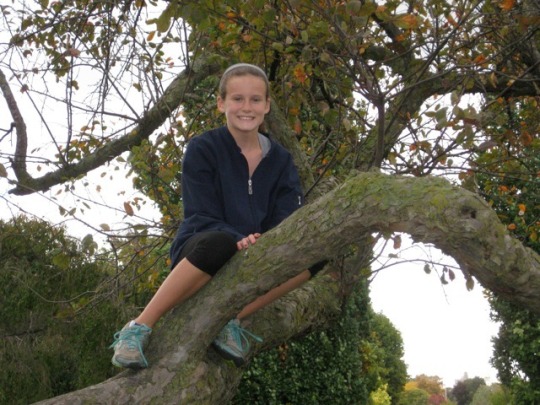
In my childhood, I was fortunate enough to attend several nature related day and overnight camping experiences. I have immersed myself in the natural world and have experienced the value of an effective nature interpreter. Now that I am of the age of previous camp councillors and teachers, I am passionate about the natural world, specifically aquatics, and am eager to be the voice for the next generation. Little 5-year-old me would be ecstatic to go down to the lake and collect stones and listen to my nature guide. I think that without this exposure and exceptional guide, I would not have the same relationship with nature that I do today.

Experiencing nature in my past and this course in the present, I have a comprehensive understanding of how I would relay my knowledge about the natural world in a digestible manner. I would focus on my passion for our freshwater great lakes and the Muskoka area that I have spent countless hours exploring. As a visual learner that recognizes there are other learning styles, a YouTube show would be an ideal source to share my knowledge with the most amount of people (Beck et al., 2018, Chapter 6). Most people have access to a digital device, if not personally then at their workplace or school. With children being exposed to technology more than any previous generation, I believe a short YouTube video weekly could be engaging and an amusing way to learn. The experience I gained through creating our podcast assignments leaves me feeling better equipped to tackle such a project.
This course has inspired me in my future aspirations. Leaving Guelph, I have the responsibility to myself and to my peers to share the knowledge we have gained in traditional study and apply it to our everchanging world. It is important to remember that regardless of what the future holds, our natural world can provide us with answers. We must support each other in our call to action and have an open mind to new possibilities and perspectives. I believe we all have been working on finding our own voice this term and I am excited to see where our values, beliefs, and interests take us.

I hope that you all can appreciate the evolution of me and my experiences outdoor through this digital scrapbook of my life through the images.
Cheers to a great term and staying curious!
References
Beck, L., Cable, T. T., & Knudson, D. M. (2018). Interpreting cultural and natural heritage: for a better world: Chapter 3 Values to individuals and society. Sagamore Venture.
Beck, L., Cable, T. T., & Knudson, D. M. (2018). Interpreting cultural and natural heritage: for a better world: Chapter 7 Serving diverse audiences. Sagamore Venture.
Beck, L., Cable, T. T., & Knudson, D. M. (2018). Interpreting cultural and natural heritage: for a better world: Chapter 6 How people learn. Sagamore Venture.
Hooykaas, A. (2024). Unit 10: Nature interpretation’s role in environmental sustainability. University of Guelph. https://courselink.uoguelph.ca/d2l/le/content/858004/viewContent/3640015/View
6 notes
·
View notes
Text
Hi there!
I enjoyed reading your ethics and beliefs that guide you as an interpreter. As I read your post, I was able to connect with many of the points you mentioned. I share the belief that human life is strongly interconnected to the environment. Like you, this belief is a major driver in my desire to be a nature interpreter. I often find it funny how humans feel we are separate from nature. Do we not come to life the same way animals do? Do humans not rely on the oxygen that forests produce or the freshwater and the life it supports? Does nature not have a great influence on our lives? We certainly have a huge impact on the ecosystems we have dissociated from. One of the main reasons I have chosen to study environmental science is to help show people that we humans are as interconnected to the environment as any other living thing. Like you, I hope to be a voice that can help build people's emotional connections to our natural world. Strong feelings of love and appreciation for nature are the most vital factors to living a more environmentally conscious person.
I can agree that I would also take a holistic approach to nature interpretation. The use of art, history and science in interpretive programs provides people with a broader understanding of topics covered during a program. Additionally, having a multidisciplinary approach creates a greater chance of connecting to the whole audience. You mention that you would focus on ecological and historical insights as you have a background in these topics. It is important to be knowledgeable when interpreting nature to people. Focusing on our strengths is a good way to provide solid interpretive programs.
Thank you for sharing your ethics and beliefs. Your passion for the environment will make you excel as an interpreter.
Tess
ethics as an interpreter
As I embark on my journey as a nature interpreter, I find myself being guided by mainly my personal beliefs and responsibilities. This ethical base is a compass that leads me towards more understanding and appreciation.
One of my personal beliefs lies in the interconnectedness of life forms and our ecosystems. I view nature as a vital part of our existence as it is and deserves respect for its beauty, importance and abilities and should thus not be seen as separate from humanity. This belief fuels my passion for being a nature interpreter as I strive to convey interconnectedness to others.
Another huge contributor to my personal ethics is the responsibility I feel towards both the natural world and the people I engage with as an interpreter. I find myself to be a mediator between these two and thus it is my responsibility to bridge the gap between us humans and the rest of the beautiful natural world. Along with this role comes the duty to inspire and install a sense of wonder. Through fostering a deeper connection to nature in these individuals I can empower them to become advocates for environmental conservation and sustainability as well and spread awareness.
Through fulfilling my responsibilities of being a nature interpreter, there are a few approaches that reflect my personal ethics. First, prioritizing authenticity in my interactions with the audience and natural world is a top priority as I strive to ensure the information being presented is accurate and clear so that everyone is able to understand and acknowledge the importance and complexity of our ecological systems.
I also embrace a holistic and interdisciplinary approach to nature interpretation through insights from ecology and history. This is because I have taken a variety of history in the environment and animals in history courses as well as a field ecology course that helped me connect to nature on an even deeper level and sharing these insights with others will help resonate on a more intellectual and emotional level.
Lastly, I am committed to ensuring that everyone is able to enjoy nature. Ensuring that everyone has the opportunity to experience the transformative power of nature regardless of their background or circumstances is my top priority.
As I continue to develop as a nature interpreter it is also important that I learn and grow with it and am mindful of the evolving nature and am open to new ideas, perspectives and experiences that challenge and deepen my understanding of the environment. My main goal is to inspire others to discover, reflect and act towards a more harmonious relationship with our natural world.
14 notes
·
View notes
Text
Guiding Ethics and Beliefs as a Nature Interpreter
Through this course, I have delved deeper into the world of interpretation. Thank you for joining me as I shared my growing knowledge of nature interpretation. In this last blog post, I will share how this course has shaped my ethics as a nature interpreter and the beliefs that will guide me to be a trustworthy interpreter who can inspire people to see the beauty of nature.
As I continue to develop as a nature interpreter, one of my guiding principles will be respect. Good interpreters must show their audience respect. As an interpreter, I will see the moral worth of all visitors (Beck et al., 2019). I will continue to respect the beliefs of others even if they don't necessarily align with my values.
I will understand that everyone has a different background with nature and environmental sustainability. Not everyone has had the privilege to grow up immersed in nature like myself. It would be unreasonable to think people who have had little outdoor experience should feel connected to nature. It is my responsibility to recognize my privilege and work to help make the outdoors accessible to underserved populations.
I will consider the reasons people seek out interpretation and will strive to provide everyone with a positive experience. I will also respect when people come to different conclusions than what I may have intended. As an interpreter, it isn’t my job to tell the audience what conclusions they should come to. My job is to guide people to find their own conclusions.

Here is a picture I took of the Uxbridge Brook in my home town last summer.
Not only will I respect the audience I interpret to. I will also respect the environment and the traditional lands I interpret by sharing accurate and authentic information. My responsibility as an interpreter is to share true information about natural heritage sites and environmental themes.
It is my job to know the geological history and ecological diversity of life found at the natural heritage site. Visitors must be able to trust that I am knowledgeable and can provide them with accurate information.
Additionally, as an interpreter, I must be able to share the authentic and accurate cultural history of natural heritage sites. To be a credible interpreter I must work with Indigenous people to ensure I share their truth accurately and respectfully.

This is a picture I took of an aquatic plant growing on Six Mile Lake in Muskoka.
Nature interpretation must be more than just showing people a beautiful natural landscape or conducting fun outdoor games and activities. Nature interpretation helps visitors see the authentic and whole story of a natural or cultural heritage site. It is through entertaining, educational, inspiring, and accurate stories that interpreters can bring greater meaning to natural landscapes. Interpretation would be meaningless if it did not provide the audience with true information that they can use to build emotional and intellectual connections (Beck et al., 2019).
Integrity will be a leading focus of mine that will guide me as an interpreter. Not only will I maintain integrity through providing true, accurate and authentic interpretive programs. I will also maintain integrity as an interpreter by striving to grow and share my love for the environment. As a nature interpreter, I must appreciate the beauty of nature in my daily life. I will accomplish this by taking environmentally positive actions and taking time to see the beauty in our natural world. Interpretation would be meaningless if the person providing these experiences did not have a deep love and respect for the land and those who call it home.

Here is a picture of an insect that I landed on my finger at the Etobicoke Outdoor Education Center.
Another belief that guides me as an interpreter is that everything in nature has intrinsic value. Intrinsic value is a mindset that means nature has value independent of humans (Rea & Munns, 2017). For example, through an intrinsic lens, a tree has value for simply existing and not because it provides humans with oxygen or lumber. As an interpreter, I would share my perspective that nature has its own value. I would do this not to change the way people value nature but to open people's eyes to a new perspective of nature. Interpretation programs should reach all audiences. Not everyone will connect with this type of thinking, so I must provide multiple points of view so people can draw their own conclusions. Some people may appreciate nature for what it does for humans. I can also relate to this as my love of nature stems from how it makes me feel.

This is a picture I took on a beach in Nova Scotia.
Environmental sustainability is one of my core values. I will continue to share my enthusiasm for the environment and stewardship with my audience. I will do everything in my power to provide audiences with interpretive programs that share the truth and beauty of a natural heritage site to provide people with emotional connections to nature.
Moving forward as a nature interpreter, it will be important that the interpretive programs I am a part of focus on giving people a greater appreciation of nature and environmental stewardship. It is my responsibility to provide visitors with positive interpretive experiences outdoors that build both emotional and intellectual connections (Beck et al., 2019). As highlighted throughout this course, positive experiences in nature are key to providing people with a deeper appreciation for nature. The appreciation people come to have for nature motivates people to find ways to sustain the earth's resources.

I took this picture of a beautiful sunset at my cottage on Six Mile Lake.
My job as a nature interpreter is to do more than just share information with my audience. It is my job to inspire people to think critically about nature. By showing an audience the beauty of nature, I can get people to care about the environment. As an interpreter, I will use a multidisciplinary approach that utilizes art, history, and science to share the earth's beauty (Beck et al., 2019). This could include guided biodiversity hikes, nature journaling, telling stories about the land and the people who call it home, and sharing art that captures the beauty of nature and other activities. Once I get people interested in what the earth has to offer, I will introduce topics of conservation effects, sustainability, climate change and ways people can get involved.

Here is a picture I took last summer of a honey bee worker foraging.
Nature interpretation is an opportunity to get people interested in environmental protection. It is essential to inform people about human's role in environmental issues. However, I have to share these topics in a way that creates meaningful and hopeful experiences. When addressing environmental issues, I will focus on the positive and get people excited about how society can become more connected to the environment. This could involve sharing positive advances in conservation efforts, habitat restoration, environmental policies and citizen science initiatives people can join.

I took this picture of a tiny frog balancing on a plant stem in my backyard.
The lessons learnt through this course will be vital as I interpret nature through my environmental science program, as a scientist or interpreter in a park. I will continue to use respect and integrity as guiding values to provide meaningful interpretive programs. I will use my knowledge and personal love of the environment to share the beauty of nature. As an interpreter, I will make it my mission to give people deeper emotional and intellectual connections to the natural world.

This is a picture I took of the Atlantic Ocean off the coast of Cape Breton Island in Nova Scotia.
References
Beck, L., Cable, T. T., & Knudson, D. M. (2019). Interpreting cultural and natural heritage: For A Better World. Sagamore Publishing.
Rea, A. W., & Munns, W. R. (2017). The value of nature: Economic, intrinsic, or both? Integrated Environmental Assessment and Management, 13(5), 953–955. https://doi.org/10.1002/ieam.1924
3 notes
·
View notes
Text
Hello!
I enjoyed reading your blog post!
I couldn’t agree more that the uniqueness of nature is truly amazing. You do an excellent job illustrating the diversity found in nature. When I think of the diversity found across the planet, I first think of how ecosystems can vary drastically in appearance, structure, and function. For example, I think of how different life in the Arctic is compared to the Amazon rainforest. Or even the vastly different Boreal Forest and Prairie biomes found in Canada.
In your blog, you highlighted the uniqueness of nature that may be less obvious at first glance but is no less incredible. As you mentioned when one takes the time to be present in nature one can see the incredible uniqueness found within the same natural area. Every tree grows and bends distinctly. Every stream bends and curves across the landscape differently. Every monarch butterfly will have variations in the spots seen on their wings.
The trails located off Rodgers Road in Guelph are a beautiful example of the uniqueness of nature. As you walk down this trail you are first surrounded by tall deciduous trees such as sugar maples, beech trees, black cherry trees and more. As you walk a few meters into the forest the trees abruptly change, and you are surrounded by eastern white cedar trees. I love cedar trees because of their uniqueness. In just one forest you can find many different habitats and life forms. It is truly beautiful.
Taking the time to examine the uniqueness of nature allows people to see the beauty in every ecosystem. This is something that those who live in urban environments may lack. Being exposed to the diversity of nature helps diminish the disconnect city people may have with the environment. The ability to see the beauty in nature is critical for building emotional and intellectual connections that foster sustainable actions (Beck et al., 2019).


Here are two pictures at different points along the recreational trail off Rodgers Road in Guelph.
References
Beck, L., Cable, T. T., & Knudson, D. M. (2019). Interpreting cultural and natural heritage: For A Better World. Sagamore Publishing.
Unit 09 - The Amazing Uniqueness of Nature
I think the most amazing thing about nature to me is the fact that every area unique and has its own distinct variables. And I know that there are obviously similarities in specific areas and similar habitats and ecosystems but what I'm really talking about is how there's no complete replication in nature. Every single path that you take will be different from the next.
I think about this fact quite often actually because growing up in a more rural area I was constantly surrounded by unique areas. I think that living in the city with all its buildings, streets, and other urban developments, can make it easy to view the areas we live in as very standardized and similar to other places. And this makes sense because a lot of buildings are built the exact same, streets are built the exact same, lots is built the exact same. But in nature everything is different.
This contrast between urban and rural environments often leaves me thinking about how intricate and extensive nature is. It serves as a reminder that our envinroment is made up of many distinct components, all of which add to the wonder and beauty of our world. There are always exciting discoveries to be made, new paths to take, and new viewpoints to acquire—even in seemingly familiar surroundings.
This uniqueness is also what allows for everyone to have their own unique connections and views, encouraging every person to discover, become knowledgeable of, and engage with nature’s wonders (Beck et al., 2018).
Personally, I love going on walks to clear my head and get some fresh air, as I’m sure many of us do. It's amazing how nature can deliver a new experience each time I walk outside. There are always fresh sights, sounds, and smells to explore, even in the same old surroundings. Every step turns into an exploratory adventure and an opportunity to form deep connections with the nature. I think one reason why I’ve always been drawn to nature is due to the fact that it's always changing.
Imagine walking through a luscious green forest, where every turn reveals a new surprise. The trees that surround you are more than just ordinary trees; they tell unique stories, all holding their own responsibilities to their ecosystem. You take in the noises of hidden animals, the brightly coloured petals of blooming flowers, and the intricate patterns of leaves as you walk. Then as you turn the corner, you see a glistening blue lake, peaceful and calm. Every part of this path is fresh and unseen before, leaving you guessing at what may come up next. This is what the uniqueness of nature provides during every outing. Whether it leaves you with good memories or perhaps even some that are not as enjoyable, each experience in nature leaves it's audience with a unique memory of a unique adventure.
While I feel that my explanation of this may not be the most clear explanation, I hope that you were still able to understand the type of feeling I was trying to decribe. Hopefully some of you have experienced this for yourself and can relate to my thoughts.
References:
Beck, L. Cable, T. T. & Knudson, D. M. Interpreting Cultural and Natural Heritage: For a Better World. Available from: Sagamore Publishing LLC, Sagamore Publishing LLC, 2018.
5 notes
·
View notes
Text
The Amazing Resilience of Nature
One of the most amazing things about nature is the incredible examples of resilience seen within ecosystems. In a world that is constantly changing, nature can persist through even the harshest conditions to bounce back to its original form or make way for new life.
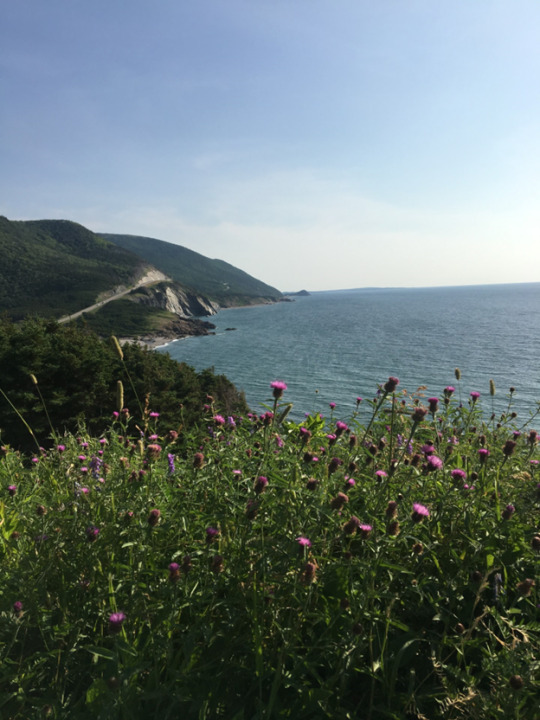
What is resilience? There are many different definitions of resilience used in ecology. Ecological resilience can be described as a natural system's ability to absorb the effects of a disturbance before the system changes states (Death, 2024). Engineering resilience is a natural system's ability to bounce back from disturbances to its previous state (Death, 2024; Thorogood et al., 2023). Overall, resilience is the ability of an ecosystem to maintain its structure or function with little change following a disturbance.
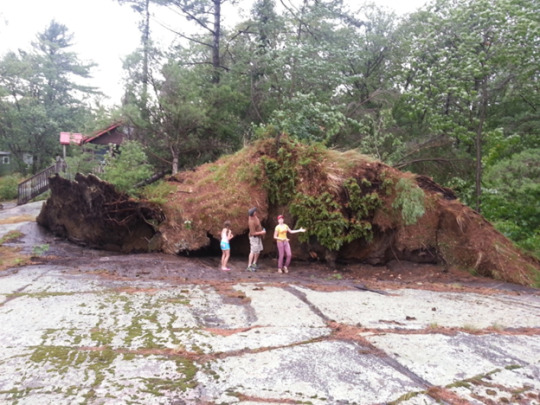
Here is a picture my mom took of tree roots that had been lifted from the ground after a downburst occurred at our cottage. After my dad cut the fallen trees, the roots and attached soil fell back over the rocks. The next year many of the trees survived and new trees and shrubs grew.
The disturbances ecosystems face can be naturally occurring events such as seasonal floods, storms, and wildfires. Humans create additional pressures such as climate change, urbanization, overexploitation of natural resources, pollution, the introduction of invasive species and more (Thorogood et al., 2023). It is the organism's and ecosystem's ability to prosper in the face of these events that makes a natural system resilient.
It may be hard to believe but wildfires can be good for an ecosystem. Forests in Canada have experienced periotic natural disturbances such as fires, insect infestations, diseases, and floods for thousands of years (Canada, 2023). These forests have adapted to these conditions to live through these events (Canada, 2023). These natural disturbances are a natural part of the life cycle of forests and even help renew life in these areas (Canada, 2023).

Here is a picture of a wildfire burning near the Pondosy Bay Wilderness Resort in B.C. (Laanela, 2018).
As a fire swipes across a forest, a door is opened to allow new life to grow. As the tree litter on the forest floor burns, nutrients that have been stored are released back into the soil. These nutrients allow soil to support the growth of new plant and tree life. Forest fires open the forest canopy supporting new life to grow as sunlight reaches the forest floor (Canada, 2023). Amazingly, some species of tree such as lodgepole and jack pine trees need forest fires to reproduce (Bushey et al.; Canada, 2023). The heat from forest fires allows the cones on these trees to open and release their seeds. Without forest fires, these tree species would not be able to reproduce (Bushey et al., 2023).
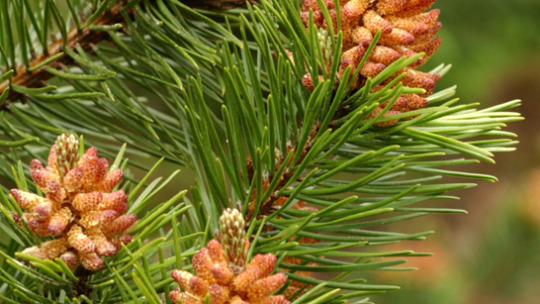
This is a picture of the cones on a lodgepole pine tree. Picture from Forestry England (n.d.).
Forest's ability to survive and create new life following wildfires is an incredible example of natural resilience. However, the increased frequency and intensity of wildfires in the wake of climate change can reduce forests' resilience to fires (Bushey et al., 2023).
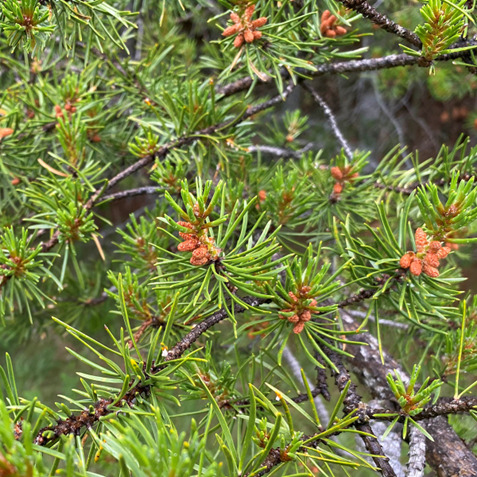
This is a picture of the cones on Jack pine trees. Picture from the Ontario Ministry of Natural Resources and Forestry (2014).
Humans can disrupt the remarkable resilience of many ecosystems through anthropogenic activities. For example, when extreme forest fires or floods occur annually there is not enough time to allow even the most resilient animals and plants to bounce back. However, when humans support nature, the true resiliency of nature can be truly inspirational.
The reintroduction of Yellow Stone wolves is a story I am sure many of you have heard. Between 1872-1926 wolves were hunted and removed from Yellowstone. Following the eradication of gray wolves, elk populations doubled, and overgrazing caused many plants and trees to die off (Peglar, 2023). The entire ecosystem was disrupted.
Rodent and bird populations declined due to habitat loss (National Geographic, 2024). Grizzle bear populations declined due to the lack of berries needed to eat before hibernation. The riverbanks eroded due to overgrazing and caused sediment to affect the water quality (Peglar, 2023; National Geographic, 2024). The whole ecosystem changed because of the loss of the gray wolves.
youtube
On January 12, 1995, eight wolves from Jasper National Park in Alberta were introduced to Yellowstone. A total of 41 wolves were introduced. Following this, the elk population was reduced and helped prevent overgrazing. The wolves even created elk populations more resilient to drought due to the thinning out of weak and sick elk (Peglar, 2023).
The wolves prevented elk from overgrazing along the river. This allowed trees to grow along the riverbank, protecting the river from erosion (Peglar, 2023). This improved water quality and supported beavers and aquatic organisms to increase in numbers (National Geographic, 2024). The reintroduction of gray wolves to Yellowstone National Park with the help of humans promoted biodiversity and higher resilience to this ecosystem.
Nature is incredibly resilient to the ever-changing conditions of the environment. With conservation efforts seen in natural areas and everyday action taken to protect the environment, people can help support the resilience of nature. By maintaining resilient ecosystems, humans and nature can thrive in a constantly changing world.
References
Bushey, D., Osmer, M., Green, H., Garneau, D., & Lesser, M. (2023). Forest resilience and regeneration dynamics following wildfire disturbance. Ecosphere, 14(9). https://doi.org/10.1002/ecs2.4655
Canada, N. R. (2023, June 22). Why forests need fires, insects and diseases. Natural Resources Canada. https://natural-resources.canada.ca/our-natural-resources/forests/insects-disturbances/why-forests-need-fires-insects-and-diseases/13081
Death, R. G. (2024). The resilience of Riverine Ecological Communities. Resilience and Riverine Landscapes, 23–39. https://doi.org/10.1016/b978-0-323-91716-2.00016-9
Enel Group. (n.d.). Ecological resilience: How ecosystems adapt to change. Enel. https://www.enel.com/company/stories/articles/2023/03/ecological-resilience
National Geographic. (n.d.). Wolves of Yellowstone. Education. https://education.nationalgeographic.org/resource/wolves-yellowstone/
Peglar, T. (2023, June 22). Yellowstone’s most controversial residents. Yellowstone National Park. https://www.yellowstonepark.com/park/conservation/yellowstone-wolves-reintroduction/
Thorogood, R., Mustonen, V., Aleixo, A., Aphalo, P. J., Asiegbu, F. O., Cabeza, M., Cairns, J., Candolin, U., Cardoso, P., Eronen, J. T., Hällfors, M., Hovatta, I., Juslén, A., Kovalchuk, A., Kulmuni, J., Kuula, L., Mäkipää, R., Ovaskainen, O., Pesonen, A.-K., … Vanhatalo, J. (2023). Understanding and applying biological resilience, from genes to ecosystems. Npj Biodiversity, 2(1). https://doi.org/10.1038/s44185-023-00022-6
Picture Credits
Forestry England. (n.d.). Lodgepole Pine. Forestry England. https://www.forestryengland.uk/article/lodgepole-pine
Laanela , M. (2018, August 15). B.C. declares state of emergency as hundreds of wildfires burn across province | CBC News. CBCnews. https://www.cbc.ca/news/canada/british-columbia/b-c-declares-state-of-emergency-as-hundreds-of-wildfires-burn-across-province-1.4785983
Ministry of Natural Resources and Forestry. (2014, July 18). Jack Pine. ontario.ca. https://www.ontario.ca/page/jack-pine
3 notes
·
View notes
Text
Hi!
I enjoyed reading your thoughts on the connection between nature and music in this week’s post.
I agree that music can be any arrangement of sound that comes together in a way that evokes emotion. Music can be an arrangement of notes deliberately placed to elicit emotion in the listener. Music can also be a mix of random sounds heard in nature. The diverse sounds found in nature come together to form music that can have an equally strong emotional response as music that takes people hours and hours to compose.
I can relate to your statement that the music found in nature can make a person take the time to truly listen. Whenever I venture out into a busy city or shopping center, I find myself putting my headphones on so I can escape to my music. But when I find myself surrounded by nature, I take my headphones off and take in the sound of birds chirping, the breeze rustling the leaves or the calming sound of rushing water.
I enjoyed reading your interesting explanation of where nature is in music. Indeed, music cannot be created without nature. I had not thought about the fact that nature's resources are not just a source of inspiration to create music. Without these resources humans and animals could not create the sounds that form music.
Nature provides resources and a way of life that has inspired cultures all over the world to create music for centuries (Gray et al., 2001). Gray, et al (2001), also suggested that there may be a natural need for living things to create music that pre-dates humans. This further supports the idea that nature is the precursor of music.
I can see how the song “Pure Imagination” transports you back to nature. It is cool that music doesn’t necessarily need nature themes to remind people of nature. This shows how music can build emotional connections to nature. The lyrics, “If you want to view paradise, simply look around and you will” express my feelings of being in nature. Paradise to me is being surrounded by nature and when you take the time to look around you can see nature everywhere.

Here is a picture I took at my cottage. To me this is paradise.
References
Gray, P. M., Krause, B., Atema, J., Payne, R., Krumhansl, C., & Baptista, L. (2001). The Music of Nature and the Nature of Music. Science, 291(5501), 52. https://link-gale- com.subzero.lib.uoguelph.ca/apps/doc/A69270354/AONE?u=guel77241&sid=bookmark-AONE&xid=fb9366a8
Finding Music in Nature
Hey everyone, welcome back:) This week I am going to dive into analyzing nature interpretation through music.
Where is music in nature? I think in order to answer this question we must first understand what defines music to be considered music. The Oxford dictionary defines music as “the art of combining various sounds to produce beauty of form, harmony, and expression of emotion” and this ties nicely with Gray, P. et al (2001) definition; music can evoke “emotional, social, cultural, and cognitive responses from patterns of sound varying in pitch and time”. I think the main takeaway from these two definitions shows how music is simply any form of frequency loud enough to be heard, that in some way or not elicits some type of emotional response. This thought can be backed up from the thoughts of Silene (2021), who states, “when we hear music we first get a feeling and then thoughts''. When I first read that quote, it made me realize how true it was and how many times that happens to me when I’m in nature. And so, I think music in nature is found in any audible frequencies whether that be leaves blowing in the wind, the sound of rain hitting the floor, or the abundance of wildlife calling throughout the night, that makes you conscious take time out of your day to pause and listen; to feel before you think.
A well-timed hike and bright sunshine = listening to the amazing sounds of lake trout splashing their way up stream
Where is nature in music? Similar to many factors of life, I believe nature is a precursor for the creation of music. The latter can not be perceived until the former creates tangible vessels for which the latter can be heard from. This thought can be explained from a more literal standpoint to a subjective one, i.e., music without words could not have been created without the tangible resources of nature (literally). While subjectively, nature provides inspiration of sounds that can be translated through an instrument or voice. Gray, P. et al (2001) references how closely tied a modern-day orchestra is to the ambient sounds of an environment; “the voice of each creature (or flora) has its own frequency, amplitude and duration…to which occupies a unique niche among other musicians”. I think this quote sums up nicely how nature is found in music, each organism is its own unique instrument, some can be grouped together but have different pitches and forms, similar to the plethora of brass instruments producing different pitches and sounds, such as baritones and trumpets.
youtube
While speaking of nature and music, I can’t help but think of times when music has enhanced my own experience with nature. One song that immediately pops into my mind when I think of being immersed in nature is “Pure Imagination” sung by Gene Wilder. At first glance, the song does not necessarily reference nature, but it is the context of where I listened to it that matters. It was on a warm summer's night, accompanied by four of my closest friends, lying down under a flowering crabapple tree at 2am in the morning. The combination of my environment just transformed my experience listening to this song. Feelings of nostalgia, being a kid again, not having a worry in the world but focusing on the warm summer air and the fragrant perfumes of the crabapple flowers. I will forever remember that feeling of pure bliss as the music and ground coarse through my body.
References:
Gray, P. M., Krause, B., Atema, J., Payne, R., Krumhansl, C., & Baptista, L. (2001). The Music of Nature and the Nature of Music. Science, 291(5501), 52. https://link-gale-com.subzero.lib.uoguelph.ca/apps/doc/A69270354/AONE?u=guel77241&sid=bookmark-AONE&xid=fb9366a8
Hooykaas, A. (2024). Unit 7: Nature interpretation through music. University of Guelph. https://courselink.uoguelph.ca/d2l/le/content/858004/viewContent/3640021/View
Oxford languages and google - english. Oxford Languages. (n.d.). https://languages.oup.com/google-dictionary-en/
Silene, A. (2021, February 20). Spiritual values of protected areas of Europe: Workshop proceedings. [pages 129-132] https://www.silene.ong/en/documentation-centre/spiritual-values-of-protected-areas-of-europe-workshop-proceedings#Proceedings_Spiritual%20Values_PAs_Europe.pdf
7 notes
·
View notes
Text
The Beauty of Nature Through Music
Our natural world has many beautiful features. The beauties of nature are not only seen by the eye but can also be heard when you listen closely. Where is music in nature? When reflecting on this question, my first thought was that music is everywhere in nature. When I step outside, I am surrounded by the music of nature.
Music is not just created by humans as a form of expression and communication. Animals like whales and birds also use songs as a form of communication.
Humpback whales communicate using songs with similar components to our music (Gray et al., 2001). These whales produce repeating rhythmic themes that form songs of similar length to musical pieces written by humans (Gray et al., 2001). The notes formed by whales are similar in tone, timber and intervals to those used by humans (Gray et al., 2001). The beautiful yet eerie songs produced by whales are a prime example of where music is found in nature.
Here is a video my sister took of a humpback whale while she was in Nova Scotia.
Numerous bird species communicate through song. Birds use rhythmic patterns and changes in pitch to create songs to communicate with other birds (Gray et al., 2001). Birds will also produce songs using musical scales like those used by humans (Gray et al., 2001). When I think of music in nature, the beautiful songs created by birds are the first thing that comes to mind.
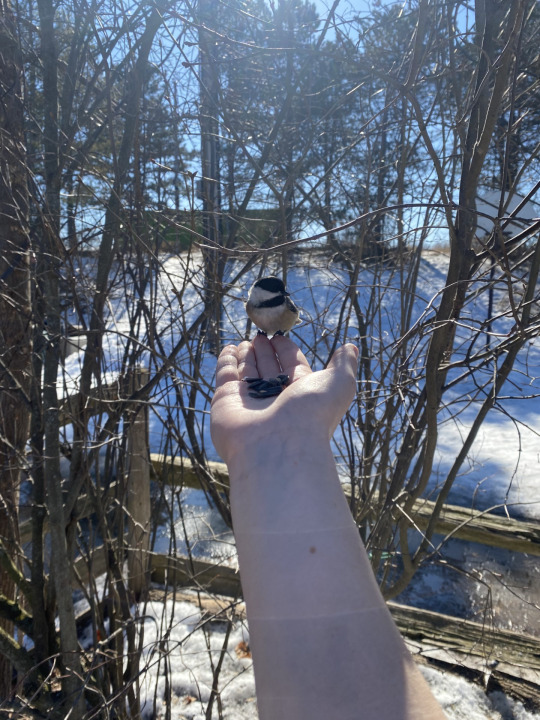
Here is a picture I took of a Black-capped Chickadee. I am sure many of you can hear the "chick-a-dee-dee-dee" call.
Ambient sounds like the rustle of leaves in the breeze or the sound of water rushing downstream are another example of music heard in nature (Gray et al., 2001). These ambient sounds heard in nature and the sounds produced by different animals come together to form a symphony or “biophony” as described by Gray et al. (2001). The biophony created in various ecosystems forms distinguishable music unique to a location.
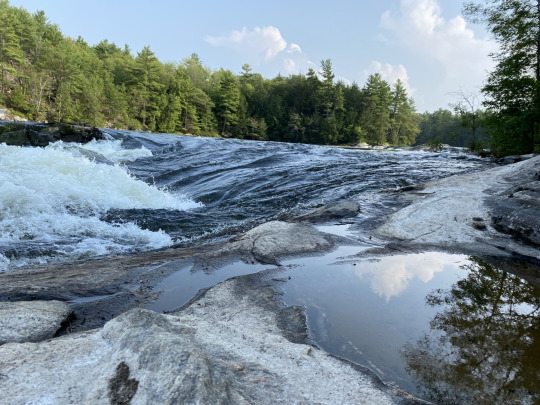
Here is a picture I took of a waterfall located on Six Mile Lake in Muskoka. Imagine the relaxing music the water makes as it crashes over the rocks.
Where is nature in music? For centuries humans have been inspired by nature. As a result, people have tried to capture nature through music. From folk music dating back centuries to Vivaldi’s Four Seasons to modern-day music, nature has inspired humans to create music.
As stated by Mallarach (2012), folk music is found in all cultures and often expresses the importance of the natural world. Folk music is an art that elicits emotions while building people's connection to their natural surroundings (Mallarach, 2012). Finnish folk music has been used to pass down messages on how sacred nature is to humans and how people can live in tune with nature (Mallarach, 2012).
The Sami indigenous people of Scandinavia create vocal songs called yoiks to describe life, animals and natural places (Gray et al., 2001). The yoiks have no words but are made up of repetitive cycles (Gray et al., 2001), much like the songs birds and whales communicate with. Finnish folk singers and the Sami people communicate through music to share the beauty and significance of nature in their communities.
Interpreters can use music to share knowledge of natural heritage places. The use of music in nature interpretation helps interpreters paint cultural and historical pictures of natural landscapes and resources (Beck et al., 2019). Also, music can help deliver environmental sustainability messages in memorable ways that provoke the listener's emotions (Beck et al., 2019).
I have a strong emotional connection with the song “Island in the Sun” by Weezer. This song transports me to my cottage on Six Mile Lake. I have spent countless summer days at my family cottage sitting on our dock listening to this song on the radio station my parents love. When I hear this song, I can picture the island my cottage is on. I can see the red roof of our cottage peeking out over the tall white pines that grow over the hard rock of the Canadian Shield. I can feel the breeze blowing off the water as the sun shines down on the water.
youtube
The lyrics of this song remind me of the calming effect being at my cottage has on me:
“On Island in the sun
We’ll be playing and having fun
And it makes me feel so fine”
This song reminds me of all the fun I have had over the years swimming with my sisters, going on sunset boat rides, having campfires with my family and many more memories. This song brings back a nostalgic feeling and reminds me of the beautiful lake that made me appreciate nature from a young age.
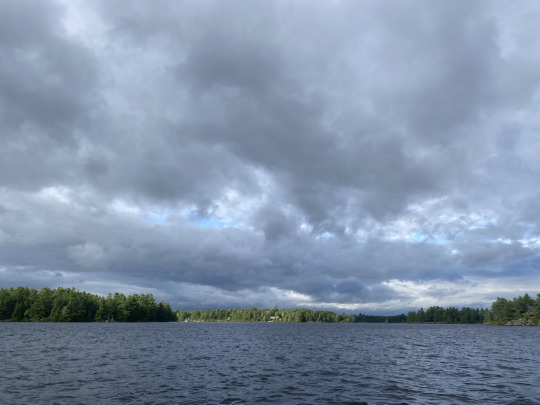
This is a picture I took of the bay my cottage looks out at on Six Mile Lake.
Music is not unique to humans. Music can be heard in the melody of birds harmonizing with the branches swaying in the breeze. Music is found in the rhythm of rain falling to the ground as spring peepers sing their chorus in the distance. Music can be heard throughout our world by humans and animals alike. The art of music is a powerful tool used to draw on people’s emotions to highlight the significance and beauty of our natural world.
References
Beck, L., Cable, T. T., & Knudson, D. M. (2019). Interpreting cultural and natural heritage: For A Better World. Sagamore Publishing.
Gray, P. M., Krause, B., Atema, J., Payne, R., Krumhansl, C., & Baptista, L. (2001). The Music of Nature and the Nature of Music. Science, 291(5501), 52. https://link-gale-com.subzero.lib.uoguelph.ca/apps/doc/A69270354/AONE?u=guel77241&sid=bookmark-AONE&xid=fb9366a8
Mallarach, Josep-Maria (2012). Spiritual Values of Protected Areas of Europe: Workshop Proceedings. Bonn, Germany: Federal Agency for Nature Conservation, 2012. 170 pp. ISBN: 978-3-89624-057-6.
Weezer. (2009, June 17). Weezer - island in the Sun (official music video). YouTube. https://youtu.be/erG5rgNYSdk?si=3K8eerbPPMD5b5hc
6 notes
·
View notes
Text
Hello Vanessa!
This post is beautifully written and connecting your experience in Rome to Hyam's quote helps convey the message.
I agree that Hyams is saying that the merit of a historic place or artifact does not come from the fact that it is old. The merit of a historic thing comes from the integrity of the stories that it accompanies. You support this point by connecting to your experience seeing the Colosseum in Rome. It is easy to feel in awe when looking at buildings and cities that feel like they are from another time. But it takes hearing accurate stories from history to feel deeper a intellectual and emotional connection. As you mention, it is the stories and cultural significance of these historical places that build deeper emotional connections to the history of a place. It is the knowledge of the past lives and experiences of people who once took up the same space as you centuries prior that brings meaning to historic places.
After reading the quote by Hyams, I also concluded that he was emphasizing the importance of maintaining historical narratives. To preserve the integrity of historical accounts, memories and knowledge that have been scattered through time must be maintained. History interpreters have the responsibility of paying attention to details from the past even as the meaning of events changes with time and geographic location (Beck et al., 2019). Interpreters must tell the truth of historical events even as their meaning has changed (Beck et al., 2019). If historical interpreters allow past events to become diluted with inaccuracies, over time the true merit of history lessons is lost. Your reflection on how museums and archaeological sites maintain stories and items from ancient times illustrates Hyams's message. It is integrity that gives value to history not the age of historic artifacts, buildings, or places.
When in Rome did notice any inconsistencies between how the people in Rome tell their history compared to how people from elsewhere tell it?
I enjoyed reading your post and learning more about how maintaining historical knowledge perseveres the valuable lessons learnt from the past.
Tess
Blog 6: A Journey Through History

As I wandered through the ancient streets of Rome, Italy, I was struck by the palpable sense of history that enveloped me. Each cobblestone pathway seemed to whisper tales of past eras, inviting me to delve deeper into the rich tapestry of human experience. In Edward Hyams' profound reflection, "There is no peculiar merit in ancient things," he prompts us to reconsider the value we attribute to the relics of the past (Hyams). Drawing from my immersive experience in Rome and insights from scholarly sources, this blog post seeks to unpack Hyams' quote and explore the enduring significance of history, using my journey through Rome as a lens.
Hyams contends that integrity, not age, is what truly matters, challenging the idea that merit can only be attained by antiquity. This struck a deep chord with my memories of my time spent in Rome, where the enduring buildings and relics served as witnesses to centuries of human history. A framework for comprehending the interdependence of the past and present was offered by Beck, Cable, and Knudson's debate on the function of interpretation in fostering personal identities through historical narratives (Beck, Cable, & Knudson, 2018). As I marvelled at the Colosseum's magnificence, I understood that its significance came from the stories it told and the cultural identity it represented, not only from its antiquity.
Coherence and unity in historical interpretation are crucial, as Hyams emphasizes honesty as the foundation of merit. This idea is supported by Fleischner's definition of natural history, which emphasizes the importance of maintaining the integrity of environmental narratives by deliberate attention to the world outside humans (Beck, Cable, & Knudson, 2018; Fleischner, 2002). As I thought back on my interactions with local naturalists and citizen scientists in Rome's parks, I realized how important their work is in preserving the integrity of natural ecosystems and encouraging a closer relationship with the natural world.
Hyams emphasizes the need to comprehend and conserve historical narratives when he states that integrity requires knowledge of and remembrance of the past. Upon visiting Rome's museums and archaeological sites, I was astounded by the care with which ancient items and the stories they told had been preserved. This concept was echoed by Miller-Rushing et al.'s consideration of citizen scientists' contributions to natural history documentation, emphasizing the value of collective memory in historical interpretation (Beck, Cable, & Knudson, 2018; Miller-Rushing et al., 2012).
Hyams's moving illustration of a train station serves as a timely reminder of the mistake of ignoring the past. History transcends time to influence our present and future, just like a train station survives after it passes by. This comparison struck a chord with my travels to Rome, where the streets were alive with the echoes of long-gone civilizations, serving as a constant reminder of the influence of the past on modern culture.
Edward Hyams' quote challenges us to reevaluate our perception of history and its significance. Through my journey in Rome and insights from scholarly sources, I have come to appreciate the timeless wisdom embedded in historical narratives. True merit lies not in antiquity alone but in the integrity, coherence, and enduring impact of historical interpretation. As interpreters of history and environmental narratives, we bear the responsibility of preserving and sharing these stories, ensuring that the lessons of the past continue to resonate with future generations.


References:
Beck, L., Cable, T. T., & Knudson, D. M. (2018). Interpreting Cultural and Natural Heritage for a Better World (1st ed.). Sagamore Publishing. Fleischner, T. L. (2002). Quoted in Interpreting Cultural and Natural Heritage for a Better World (1st ed.). Sagamore Publishing. Hyams, E. (n.d.). "The Gifts of Interpretation." Retrieved from [insert link here]. Miller-Rushing, A. J., Primack, R., & Bonney, R. (2012). Quoted in Interpreting Cultural and Natural Heritage for a Better World (1st ed.). Sagamore Publishing.
6 notes
·
View notes
Text
Interpretation: Breathing Life into History
Interpretation is a powerful tool that brings meaning into objects and places that with no context may seem to hold little significance. The following quote highlights the need for historical interpretation:
“There is no peculiar merit in ancient things, but there is merit in integrity, and integrity entails the keeping together of the parts of any whole, and if these parts are scattered throughout time, then the maintenance of integrity entails a knowledge, a memory, of ancient things. …. To think, feel or act as though the past is done with, is equivalent to believing that a railway station through which our train has just passed, only existed for as long as our train was in it.”
(Edward Hyams, Chapter 7, The Gifts of Interpretation)
After reading this quote a few times, I was reminded of the goal of interpretation. The purpose of interpretation is to build intellectual and emotional connections to cultural and natural heritage through a multiple-disciplinary approach (Beck et al., 2019). Interpreters help guide people to find meaning and new perspectives that they may not have seen before.
Edward Hymas is saying that historical things on their own have little value when he states, “There is no peculiar merit in ancient things, but there is merit in integrity”. It is up to people to share the honest history of these ancient things to give them value. A similar statement is made by Beck et al. (2019): “Without interpretation, artifacts are merely old things, historic buildings are just old buildings, and ceremonies and festivals are merely entertainment” (Beck et al., 2019). Accurate in-depth stories and re-counts of an event or time give value to historic artifacts and places. It is through entertaining, educational, and inspiring stories that interpreters can bring meaning back to historic artifacts, buildings, landscapes and events (Beck et al., 2019).

I am sure most people recognize this ancient Greek structure. However, many people may not know the history. This is an image of Parthenon the temple that is located in Athens, Greece on the hill of Acropolis (Britannica, 2024). It was built for the Greek goddess Athena during the mid-5th century (Britannica, 2024). It is through learning the history of this temple that people can appreciate it for being more than just an old structure that has stood for centuries. Link: https://www.britannica.com/topic/Parthenon
“Merit in integrity” comes from interpreters who pay close attention to historical details and ensure visitors receive the most accurate and authentic retelling of history. The responsibility of historical interpreters is not to simply show visitors a piece of ancient art; the clothing and way of life of past generations; or the land where a great battle once took place. Historical interpretation is ethically responsible for sharing accurate and authentic information (Beck et al., 2019). Interpreters must strive to ensure visitors receive true information that they can make connections with and find meaning in.
Interpretation programs are authentic when interpreters provide visitors with both objective and constructed authenticity. Objective authenticity occurs by providing people with the opportunity to interact with original artifacts, buildings and locations of historic importance (Beck et al., 2019). Interpreters can construct authenticity by recreating clothing, art, and buildings that accurately reflect the period (Beck et al., 2019).

Here is a picture I took of the historic fishing village located at Peggys Cover in Nova Scotia.
Interpretation programs provide people with personal authenticity through objective and constructed authenticity (Beck et al., 2019). If interpretation programs and props provided are inaccurate and tell anything but the truth, they should not be included (Beck et al., 2019). If programs are not truthful, visitors will not experience personal authenticity (Beck et al., 2019). Personal authenticity is achieved when a person is transported back in time and feels connected to an event from the past (Beck et al., 2019). I believe integrity is achieved when interpreters can provide people with personal authenticity based on honesty. Through integrity, history is given meaning that people can emotionally connect with and learn from.
History is never truly erased. Even if people forget past events, that does not change the fact that those events have occurred. However, the meaning of history and the lessons learnt from past events can be erased when people choose to forget. This is what I believe the second half of Hymas's quote means. It is an injustice if people choose to “think, feel or act as though the past is done with.”
People can learn from past mistakes and apply lessons learnt to promote human rights and reduce conflicts occurring around the world (Beck et al., 2019). People must choose to remember the memories, struggles and suffering of people who endured horrendous events such as Slavery, the World Wars, the Holocaust, Residential Schools and many more. History interpretation allows people to dissect these tragic events and understand all that built up to these past events.

Picture taken from the Global and Mail of a memorial for Indigenous children killed at Residential Schools in Canada. It is vital to remember tragic events to understand how they have harmed people in the past and to this day. Link: https://www.theglobeandmail.com/canada/article-building-national-monument-honouring-residential-school-students-to/
Not only does historical interpretation allow people to feel the emotions of people from the past, but it also helps people understand the struggle and pain people still face today because of these events. The emotions people feel and lessons learnt from history is crucial for preventing events that go against human rights from continuing.
References
Beck, L., Cable, T. T., & Knudson, D. M. (2019). Interpreting cultural and natural heritage: For A Better World. Sagamore Publishing.
Encyclopædia Britannica, inc. (2024, January 28). Parthenon. Encyclopædia Britannica. https://www.britannica.com/topic/Parthenon
Taylor, S. (2022, March 30). Building National Monument honouring residential school students to take five years. The Globe and Mail. https://www.theglobeandmail.com/canada/article-building-national-monument-honouring-residential-school-students-to/
0 notes
Text
Hey there!
Thanks for sharing your experience with citizen science! I enjoyed learning about the Foray NL group and the community of passionate people apart of this group. I also want to get involved in citizen science, so hearing your experience really motivates me to search for projects. I think I would try to get involved in citizen science projects such as Christmas Bird Count or various NatureWatch projects. Some NatureWatch programs I would like to investigate include Monarch Watch, Frog Watch and Plant Watch. I believe citizen science could be a wonderful way to further my develop scientific skills while also actively helping to protect wildlife.
Citizen science as described by (Merenlender et al., 2016) provides people with a community and the chance to gain scientific knowledge and species identification skills. Citizen science also provides people with conservation and environmental stewardship skills that they can share with others (Merenlender et al., 2016). The experience you gained from being a part of the Foray NL group illustrates how meaningful citizen science can be to participants and its significance towards scientific research. I was so fascinated to learn that through this organization a community of people is formed from all over. It is so cool how so many people get involved to share their knowledge and help each other learn more about mushrooms and lichen.

Here is a picture of mushrooms I took while at on a hike two summers ago. What type of mushroom is this?
Merenlender et al. (2016) mention how there is little diversity in citizen science and environmental fields. It was further described how it has traditionally been hard to engage underserved populations in citizen science (Merenlender et al., 2016). I know that you mention Foray NL had Indigenous partners but what is the overall demographic of this organization? How does or how could Foray NL reach underserved populations?
To answer the question you asked, I think the mushrooms in your video are listening to “Shrike” by the Hozier.
Tess : )
References
Merenlender, A. M., Crall, A. W., Drill, S., Prysby, M., & Ballard, H. (2016). Evaluating Environmental Education, citizen science, and stewardship through naturalist programs. Conservation Biology, 30(6), 1255–1265. https://doi.org/10.1111/cobi.12737
Discovering Citizen Science
I have mentioned in previous blog posts that one of the best decisions I have made in the last 5 years was to get involved in my local mycological society. Foray NL is a not for profit collaborative group that involves folks from a variety of backgrounds including mycologists, lichenologists, indigenous partners, students and citizen scientists. All of these people get together once a year to collect, analyze, identify, photograph, and catalogue mushroom and lichen species from across Newfoundland. Each year new species are discovered, species that have never been collected before or in some cases never been identified before. There are so many different kinds of mushrooms and lichens. Lichen identification by Foray NL has helped to play a part in conservation efforts here in Newfoundland. It makes me feel like we are making a small but meaningful difference in the world. It is truly fascinating that despite the tens of thousands of specimens collected over the 20 years Foray NL has been active, we still have only grazed the surface of biological variety. This element of discovery really ignited a curiosity in me that has led to a new career path, and has helped me discover a joy in continued studies as an adult (such as this course!)
Citizen science is about asking questions and observing. Check out this mushroom house party! What kind of music do you think they are listening to?
In 2019 when I attended my first Foray NL three day event. I was initially a bit nervous, but interested in learning more about mushrooms as an amateur forager. It fascinated me to discover that there are edible food sources wherever we go. Knowing what to eat was just a matter of researching a bit more about plant and fungi biology. As a forager I wanted to know what else I could eat aside from the wild berries, Labrador tea, and plethora of edible backyard weeds. I wanted to dive head first into the woods and talk to the people that knew about wild food sources, and how not to die while eating mushrooms. What I didn’t expect was a welcoming, interesting community of people who were maybe a bit eccentric, but incredibly knowledgeable, funny, caring and ready to take on the world on mushroom at a time. I don’t remember what I was expecting, but when I stepped into the “mush-room” I was blown away. The “mush-room” is a large makeshift laboratory where all the species of mushrooms that have been collected over the weekend are laid out for identification on tables. There were piles of books for identification, a photography booth, microscopes, dehydrators and tables and tables of unique fungi and lichens. The variety was astounding to someone who really only knew about wild chanterelles. I went past each specimen taking in their names, features and examining their qualities. I observed their spores on microscope slides, witnessed bio-luminescence in the photo room, and along the way learned so much from each person I spoke with. It was fun, and I helped to contribute to the collection, my role even had a name - citizen scientist. This slow building of knowledge has been incredibly rewarding and the yearly event is something I continue to look forward to. My hope is that by sharing my story other folks will reach out to similar organizations and seek out the knowledge that lingers there. You too can be a citizen scientist!
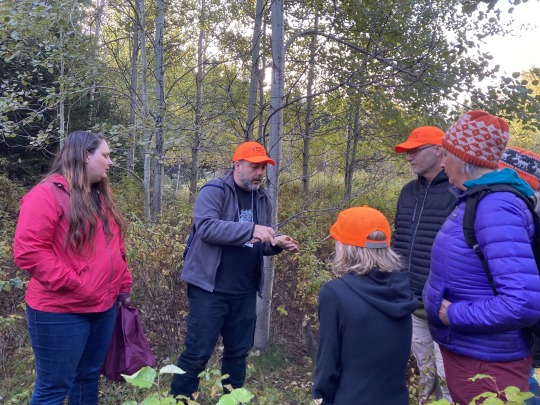
Folks at Foray NL learning about how to identify mushrooms.
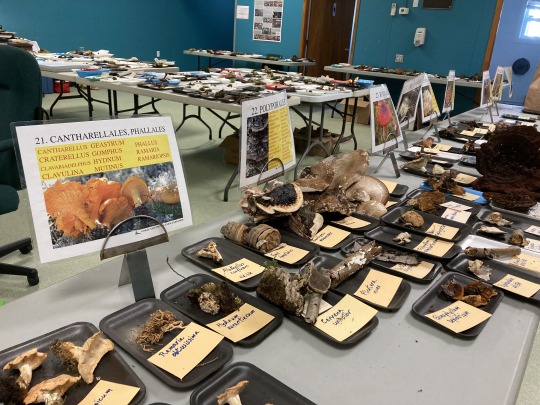
The "Mush-Room" identification tables at Foray NL

One specimen of identified mushrooms on the table.
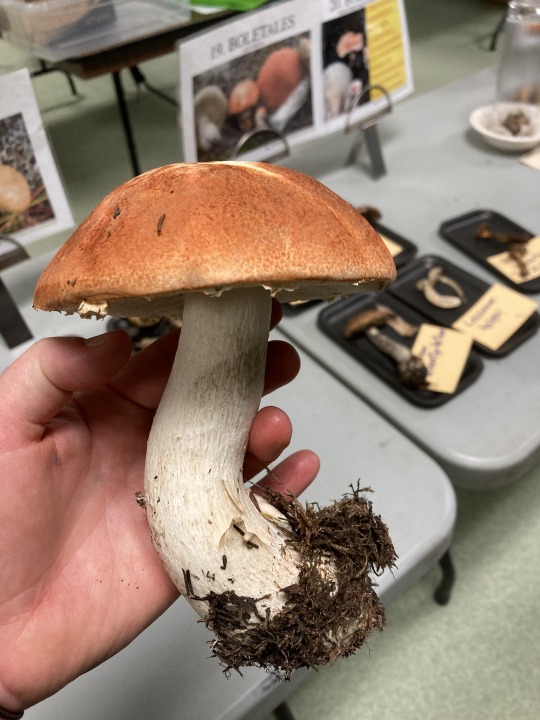
A bolete! From the tables, 2023.

Science! Is for everyone!
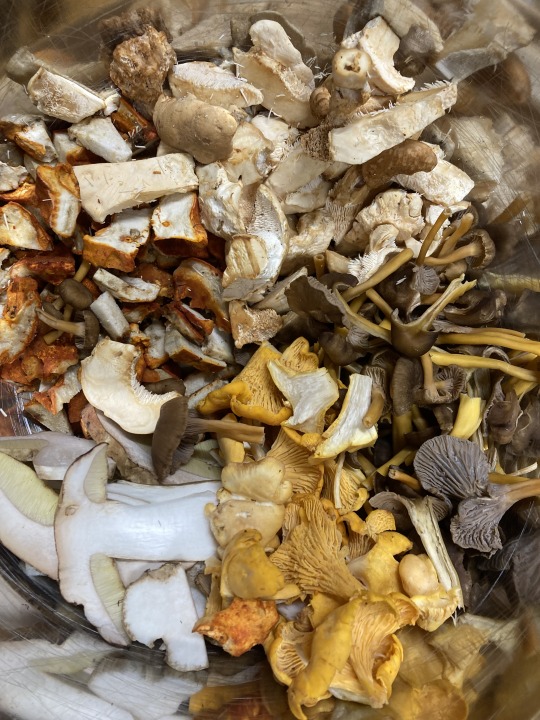
My favourite part, prepping and eating a foraged fungi feast for everyone at Foray NL to enjoy after a day in the woods collecting specimens.
8 notes
·
View notes
Text
Role of Nature Interpretation in Environmental Stewardship
Before starting this course and my placement as an Outdoor Education Intern, I put greater emphasis on scientific evidence as one of the most important ways to get people to care about environmental issues. I thought that if everyone knew the alarming facts of climate change or the rapid decline of wildlife, people would strive to make the drastic changes needed to address these issues. However, by focusing on only the science many people become disinterested or so overwhelmed that they feel powerless. Whether at a National Park, school or online forums, nature interpretation programs allow people to build emotional connections to nature while learning about the natural world and the importance of sustaining the earth's resources.
While working as an Outdoor Education Intern at the Etobicoke Outdoor Education Centre (EOEC) for my first 4-month co-op placement, I got to work with Toronto District School Board kids from grades 4-8. School groups would visit EOEC for three days where they got to take place in curriculum-based outdoor programs. Additionally, during the school trips students participated in an ecological footprint challenge that focused on reducing food waste and water and energy conservation.
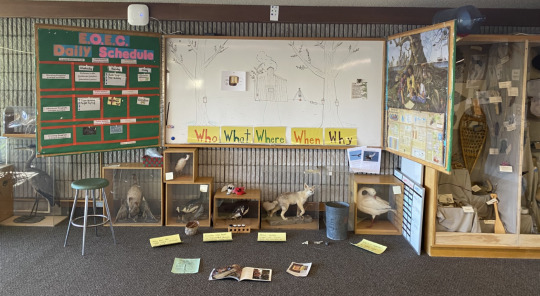
A picture I took of the main classroom at the Etobicoke Outdoor Education Centre.
At the start of my placement, I remember feeling disheartened by the number of kids who showed little interest and even apathy for being outdoors. I would wonder how these kids could not love being surrounded by the beautiful natural world. I quickly realized that many of these kids had never spent extended periods outdoors. This was due to limited access to the outdoors because of location, financial reasons and other limitations. These kids had little opportunity to gain a connection to nature, so it only made sense that few of the students had positive feelings toward natural environments. However, every week during this co-op placement, I got to help students with varying levels of outdoor experience explore new activities and gain a greater appreciation for nature, which was truly fulfilling.
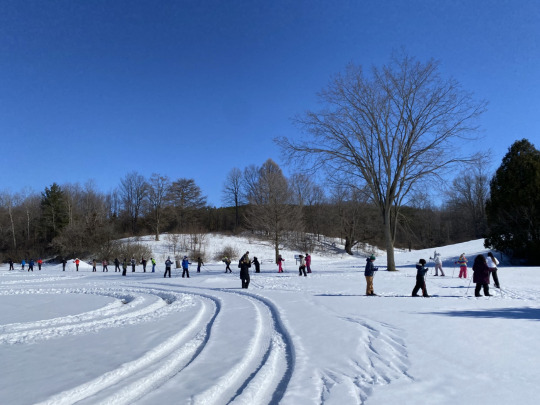
A picture of a school group cross-country skiing at EOEC. This was many of the student's first-time cross-country skiing.
This course has allowed me to reflect on my time as an outdoor education intern and better understand the significance of nature interpretation in Environmental Education. As emphasized by Beck et al. (2019), interpreters work to communicate to people the importance of resources in a way that forges emotional and intellectual connections. Environmental education should provide emotional context that allows people to think ethically, creatively, and critically about environmental issues, solutions, and personal environmental stewardship (Wals et al., 2014). Environmental education is a form of nature interpretation that connects people emotionally with nature while providing them with tools to better understand environmental problems and solutions.
Connecting scientific knowledge with place-based and indigenous knowledge is essential for getting people to actively engage in sustainability (Wals et al., 2014). Nature interpretation programs such as those at outdoor education centres and National Parks create positive emotions toward nature and provide people with a sense of place (Beck et al., 2019). Nature interpretation provides individuals with the emotional connections and curiosity that allow people to appreciate the environment. Through interpretation, people may be inspired to learn more about nature and find ways to participate in environmental stewardship daily.

This is a board students used to track their class's eco-footprint challenge results while at EOEC. Students tracked the amount of food waste produced at the end of each meal, how many lights were left on before each program and water usage.
Additionally, nature interpretation programs that supply individuals with chances to engage in stewardship efforts on their own help people continue to build strong relationships with the environment. For example, in Washington Wachira’s Ted Talk, For the Love of Birds, he conveys to the audience the beauty and significance of birds by touching on the formative experiences that led him to his passion for birds (2017). Near the end of the TED Talk, Wachira tells the audience about citizen science programs around the world that people can take part in to help bird conservation efforts. This is an excellent way to show people that they too, have the power to help protect wildlife.
Citizen science enables people to participate in environmental stewardship by assisting with scientific research within their communities (Merenlender et al., 2016). Citizen science is a part of environmental education that further develops a person's scientific knowledge and sense of place in a fulfilling way (Merenlender et al., 2016). Like the eco-footprint challenge students participate in at EOEC, citizen science allows people to feel like they can take part in meaningful environmental stewardship efforts that make a difference.

Providing people with profound experiences outdoors through nature interpretation, environmental education, and citizen science is vital to environmental preservation. Nature interpretation provides the spark of inspiration needed to see the beauty in nature and the desire to preserve the environment that science alone cannot provide.
References
Beck, L., Cable, T. T., & Knudson, D. M. (2019). Interpreting cultural and natural heritage: For A Better World. Sagamore Publishing.
Merenlender, A. M., Crall, A. W., Drill, S., Prysby, M., & Ballard, H. (2016). Evaluating Environmental Education, citizen science, and stewardship through naturalist programs. Conservation Biology, 30(6), 1255–1265. https://doi.org/10.1111/cobi.12737
Wachira, W. (2017, August). For the love of birds. Washington Wachira: For the love of birds | TED Talk. https://www.ted.com/talks/washington_wachira_for_the_love_of_birds
Wals, A. E., Brody, M., Dillon, J., & Stevenson, R. B. (2014). Convergence between science and environmental education. Science, 344(6184), 583–584. https://doi.org/10.1126/science.1250515
4 notes
·
View notes
Text
Hi Olivia!
You do a beautiful job using the photograph of Niagra Falls to describe how people use art to interpret nature daily. Your photograph and vivid description transport me back to my trip to Niagra Falls a few years ago in March. This photo brings back my memories of that trip and the excitement, awe, and admiration I felt while looking at the waterfalls.
I agree that nature Interpretation is more than just sharing information; it is also about inspiring people to learn more and see the beauty in cultural and natural heritage (Beck et al., 2019). A strong point you bring up is that everyone can connect to and feel inspired by art in one form or another. Art in its many forms, is a highly effective tool when addressing a group of people with diverse interests and perspectives. The combination of science, history and art in interpretation helps build the audience's intellectual and emotional connections to nature (Beck et al., 2019). This is essential when growing a greater understanding of the natural world.
An excellent point you bring up is how storytelling can be used to show the entirety of a place while addressing meaningful messages. The art of storytelling, whether through visual art, music or spoken word, walks people through the natural and cultural heritage of a location in an engaging way. Storytelling and art allow people to interpret the significance of a place or a natural resource for themselves. Interpretation must let the audience discover the meaning of the theme for themselves, even if the conclusions they come to were not necessarily intended by the interpreter (Beck et al., 2019). One of the most beautiful things about art is that people can see the same photo or painting; hear the same song or story but feel different emotions and come to different conclusions. Although people may find various messages within stories, music, and photographs, art allows people to find new perspectives and appreciate nature. Art connects with people in a personal way, much like nature. Appreciating the beauty of nature through art can be a vital first step to environmental stewardship.
References
Beck, L., Cable, T. T., & Knudson, D. M. (2019). Interpreting cultural and natural heritage: For A Better World. Sagamore Publishing.
Nature is art, how to use art to interpret its beauty.
Anyone can interpret nature through art. You do not need to be an artist, musician, or actor to interpret through art. It can be as simple as telling a story to set a scene and engross the audience, playing some music in the background to set the tone, or even dressing up into a costume that will demonstrate the message you want to get across (Beck et al., 2018). It is pretty simple.

This photo of Niagra Falls, ON, is art itself. Even a photograph can evoke emotion or tell a story. Looking at this photo, you can feel the mist on your face from the falls, hear the crash of water, and feel the cold wind. Taking the picture and looking back at it brings even more sense of place through remembering where I was, who I was with and what I was doing. It makes the place unique. I also want to highlight the art of nature captured in this photo. The monochrome blues and grey, textures, and sound (if you were there) are all art. It evokes emotion, which is pretty powerful!
Nature is art. The colours, shapes, perfect harmony of sounds and visual displays are like a movie. There's a reason that nature is so beautiful and why people appreciate it differently, the same as with art. It is important to help people see the beauty in what surrounds them. Some fundamental principles of interpretation highlight this fact. The first principle is that nature should be more inspirational than informational (information is not interpretation) (Beck et al., 2018). Art helps convey messages and create rich experiences, thus helping to inspire a group (Beck et al., 2018). It is also important to ensure that whatever you interpret needs to relate to people (Beck et al., 2018). This may seem challenging; however, using art helps reach people. Using music, dance, poetry, theatre, or visual art all increases the chances someone can relate to the topic you are presenting. Everyone can connect to art, whether it's through music they may recognize from parts of their own life or an art form they participate in or enjoy. It can also work to draw more diverse crowds if you incorporate art forms meaningful to a specific group or include a diverse cast for a thematic demonstration (Beck et al., 2018). This also helps remove barriers to people's learning, another essential part of interpretation. Another principle of interpretation is presenting the entirety of a place, not just one part. This can easily be achieved through storytelling. Storytelling that uses the TORE framework focuses on the main message being conveyed, is organized to provide structure and meaning, is relevant to the audience and is enjoyable (Beck et al., 2018). Storytelling can use tangible elements, almost like a prop, to associate meanings with objects from the area you are interpreting. It can help to engage an audience, create imagery and create a sense of journey (Beck et al., 2018). Strauss discusses storytelling tips, which include starting simple, using legends, folks or myths from the area to build upon, using details to really engage the audience, use a flexible voice and gestures to bring the audience into your story (also adds some thematic interpretation), and most importantly practice a lot (Beck et al., 2018).
Interpretation through music is also an extremely beneficial tool for interpreting as it helps listeners get words and facts stuck in their minds (Beck et al., 2018). It also aids in painting imagery in their heads and reaching an emotional reaction, which can help listeners feel attached to what they are interpreting and build a more profound sense of place (Beck et al., 2018).
Many natural places have complex issues associated with them (Beck et al., 2018). This can be past, present, or future issues that cover a broad range of topics, such as cultural resources on local, regional or global scales like civil rights and racial tensions or discussing climate change (Beck et al., 2018). The theatre has been used increasingly to help translate complex topics (Beck et al., 2018). It can be used to engage the public with issues such as climate change (Beck et al., 2018).
While nature in itself is beautiful and acts as its own form of art, many are quick to overlook it or may need help figuring out where to focus their attention. Using art such as music, storytelling or theatre to help interpret nature can help translate to a broader audience and ensure people take home the message you want to convey. It is an effective tool for covering complex topics and makes engaging the audience easier and more effective.
References:
Knudson, Larry Beck, Ted T. Cable, Douglas M. Interpreting Cultural and Natural Heritage: For a Better World. Available from: Sagamore Publishing LLC, Sagamore Publishing LLC, 2018.
10 notes
·
View notes
Text
The Art of Nature Interpretation
Our natural world is a major influence in my life and has inspired me to study environmental science and create art in the form of photography and paintings. I use these art forms to capture my love and appreciation for the natural world. When outdoors, I am constantly inspired to take photographs of sunsets, bodies of water, flowers, trees, and different animals. When I take these photos, I am trying to convey my feelings of wonder, excitement, curiosity, and love from that moment surrounded by nature. Similarly, natural environments are often my source of inspiration when I feel the desire to paint. When I paint a landscape or an organism, I try to visualize the beauty of the natural wonders that bring joy to my life. Through art, I try to interpret the importance of our natural world and the emotions I feel when surrounded by nature. Photographs, paintings, drawings, and music with environmental themes tend to ignite strong emotional responses in me. These emotional responses in turn influence me to learn about environmental issues and ways to protect our resources.
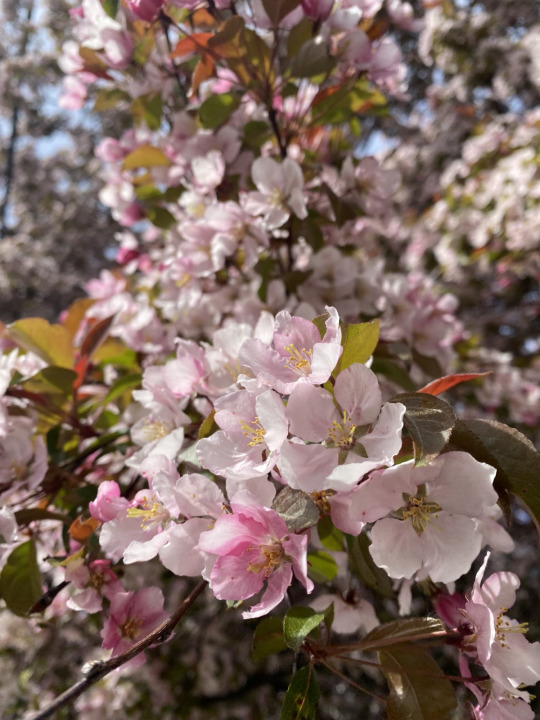
A photo I took of the crabapple tree in front of my house.
Art has been used for centuries by people around the world to interpret and capture the beauty of our natural world. Art can illustrate nature in perspectives that build new emotional and intellectual connections to the environment and its resources (Beck et al., 2019). Interpreters, such as I, can use art to deliver themes of stewardship that incorporate science while drawing on people's emotions. Interpreters can inspire people to see the value in their surroundings (Beck & Cable, 2011). Interpretation tools such as voice, movement, music, and storytelling are valuable ways to get people to determine the quality of the natural world for themselves (Beck et al., 2019). Incorporating art into interpretation exposes people to different forms of art that they resonate with and allows them to interpret themes for themselves.
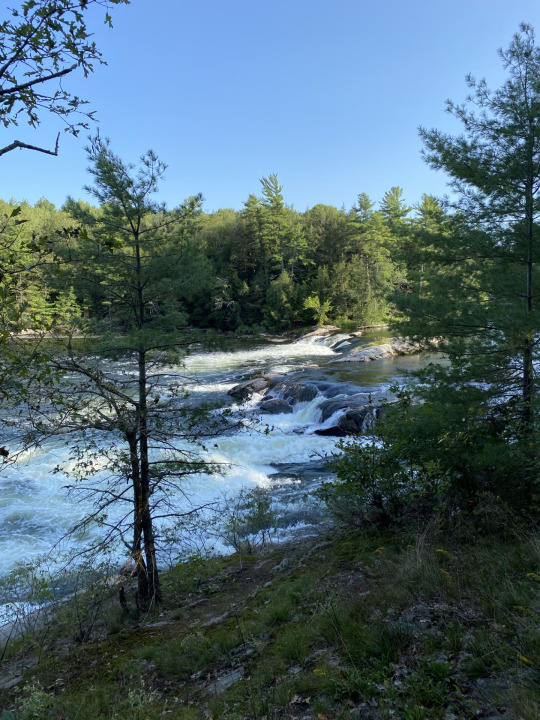
Photo taken at Six Mile Lake. The mix of shade and sunlight over the waterfall created a gorgeous scene.
Environmental education with a strong art focus can allow people to understand natural processes and issues in new ways (van Boeckel, 2014). Additionally, different art forms provide people with little exposure to natural environments and the opportunity to build emotional connections with nature, which is the first step to environmental stewardship. When people observe a beautiful piece of art that resonates with them, whether it is a painting, photography, song, or story, they may be moved to learn more and to protect our natural resources.

A photograph I took of a sugar shack used to make Maple Syrup. The beauty of the fog in the distance with the tall trees surrounding the building inspired me to take this photo.
Beck & Cable (2011) explain that interpretation provides people with the “gift of beauty”. Through the art of interpretation, people can carefully combine science, history, and art in an inspirational way (Beck et al., 2019). Interpretation with the use of art can ignite an individual's desire and ability to feel the beauty of the world. The emotional and intellectual connection gained from the “gift of beauty” promotes people's desire to protect the earth's resources. Seeing the beauty in nature is the most vital key to environmental sustainability. To me, the ‘gift of beauty’ is one of the most significant things a person can have. The ability to see beauty in our world allows people to make meaningful connections and find fulfilment every day.
References
Beck, L., Cable, T. T., & Knudson, D. M. (2019). Interpreting cultural and natural heritage: For A Better World. Sagamore Publishing.
Beck, L., & Cable, T. T., (2011). The gifts of interpretation: Fifteen guiding principles for in-terpreting nature and culture. Sagamore Publishing.
van Boeckel, J. (2014). At the heart of art and earth: An exploration of practices in arts-based Environmental Education. Environmental Education Research, 21(5), 801–802. https://doi.org/10.1080/13504622.2014.959474
1 note
·
View note
Text
Unit 3
Due to family matters I have been exempt from this week’s post.
0 notes
Text
Hey there!
I was interested to learn about your ideal role as an environmental interpreter at Greece's Santorini volcano. I have never been to Greece, so I enjoyed learning about this volcano.
You gave great insight into the importance of inspiring people as an interpreter. Environmental interpreters work to appeal to listener's interests through different forms of communication while building emotional and intellectual connections to the environment (Beck et al., 2019). I agree with you that people are motivated to seek knowledge when inspired. This inspiration can come from within or from the guidance of others, such as interpreters. My inspiration to go to university for Environmental Science came from watching documentaries about environmental issues such as species at risk and climate change. Additionally, my ideal role as an interpreter would be at a provincial or national park in Canada. This came from the many wonderful experiences I had exploring different ecosystems at these parks How did you become inspired to learn about the history of Greece and the Santorini volcano?
Another excellent point you mentioned in your post is the importance of keeping long fact-based history lessons to a minimum. By overwhelming an audience with scientific or historical information instead of captivating them and making them want to learn more, an interpreter will lose the listeners' interest. The history of a landmark and area of cultural and environmental significance is needed for interpretation but should be spread out to prevent overwhelming the listeners. A great technique you mentioned to inspire the audience was building their curiosity about the volcano's future. This is a great way to get people interested in a topic and inspire them to learn more.
Some questions I had for you are; how would you appeal to people who have a different learning style than you? How would you educate groups of varying age levels? How would you engage with people when there is a language barrier? How would your learning style help you overcome these barriers?
References
Beck, L., Cable, T. T., & Knudson, D. M. (2019). Interpreting cultural and natural heritage: For A Better World. Sagamore Publishing.
02: My Role As An Environmental Interpreter
Connecting with nature and our surroundings can be difficult, especially if we are unfamiliar with the environment. Consider someone who was reared in an urban area, such as downtown New York, and then unexpectedly relocates to the middle of nowhere in British Columbia. Although hypothetical, this is a significant change. Perhaps you haven't had much interaction with the wildlife and many species that currently surround you. There is a lot to learn about.
Helping people to bridge the knowledge gap between an uninformed person and the unending facts of the environment begins with my capacity to teach and the ability of the individual to grasp. Since everyone's learning styles varies slightly, an interpreter's delivery of information must be adjusted to each individual. As an environmental interpreter, my inspiration would come from providing people with the tools they need to comprehend the environment.
Many people learn because they want to know something (Beck, Cable, and Knudson, 2018). I'm sure any university student has experienced this firsthand; perhaps at the start of a school year, they are still in holiday mode rather than a mindset of eagerness to learn. Inspiration is extremely important in doing this. An audience must be inspired or motivated to learn more about a topic in order for it to stick in their minds (Beck, Cable, and Knudson, 2018). As stated in the text, saturating someone with facts and lengthy history leaves little room for inspiration or imagination (Beck, Cable, and Knudson, 2018).
As a natural interpreter, I'd want to communicate the fascinating history and story of Greece's Santorini volcano. The volcano is dormant yet still considered active, which is not something most people experience on a daily basis. This is a gorgeous natural item that may inspire people, as volcanoes are typically only seen in movies. My job may entail explaining the volcano's history, how it formed, and what the volcano's future holds. Sparking others' imaginations about the volcano's potential future encourages them to develop curiosity and, possibly, a desire to learn more about it.

Growing as an auditory learner differs greatly from those who require visual and hands-on experiences. I prefer gathering in-depth data to obtain as much background knowledge as I can. Furthermore, being presented with a flexible question helps me to use my existing knowledge to spark curiosity and imagination.
First and foremost, I would require high literacy abilities because I am the one teaching. Having a thorough comprehension of my topic is critical to ensuring that my audience understands the information I am attempting to convey. In addition, intrapersonal abilities and self-awareness are essential. Religion and politics are themes that may come up when discussing the environment, therefore being compassionate and considerate of others' beliefs, viewpoints, and values is essential (Beck, Cable, and Knudson, 2018). As an interpreter, I would ensure that I can educate people without using sophisticated terminology. Now, this can vary depending on elements as simple as age; some people may not be able to comprehend the facts at hand.
Overall, working as an interpreter for the Santorini volcano would let me to do things I enjoy. Learning about Greek history, spending time in Greece, and sharing the country's culture and heritage. Furthermore, motivating and encouraging others on a topic about which I am deeply enthusiastic can be quite fulfilling.
References:
Beck, L., Cable, T. T., & Knudson, D. M. (2018). Interpreting Cultural and Natural Heritage for a Better World (1st ed.). Sagamore Publishing. https://www.sagamorepub.com/products/interpreting-cultural-and-natural-heritage-better-world
3 notes
·
View notes
Text
Hi Natalie,
Thank you for taking time to read my post!
Activities such as biodiversity hikes are great ways to engage auditorial and kinaesthetic learners. Walking through a provincial park is a wonderful way to allow kinaesthetic learners to explore and learn about the surrounding environment. Biodiversity hikes also have lots of opportunities for interpreters to share stories that allow auditory learners to understand the environment as they walk along a trail. Additionally, pausing to point out things like a particular view, animal footprints, or plants on a tour can connect to visual learners. These parts of tours allow interpreters the ability to engage auditory learners through open discussions about what they are seeing. On a tour, I could also get people to feel things along the hike such as the bark or leaves of a tree if they learn through touch.
Additionally, activities like Wolf Prowl are excellent games that allow kinaesthetic learners to think about how animals move through the wild to get water and food. Activities like nature journalling create ways to connect Intrapersonal learners to the environment. Nature photography is a wonderful way to engage with visual learners. However, as mentioned in Interpreting Cultural and Natural Heritage: For A Better World, everyone can grow and develop new knowledge when participating in activities that are not tailored to their learning style.
I am a visual learner and I comprehend things when I can see pictures, diagrams, videos, or written words. I can use this as an interpreter to show people different visuals of plants and animals while I am talking. These visuals could be pictures I take or pointing out things I see while on a guided hike. I could use my visual learning skills to create informational posters and diagrams that can be posted online to help people interpret the environment. In the past as an outdoor education intern, I used visuals at the outdoor education centre such as toxidrome animals to familiarize kids with the animals found in southern Ontario. I use visuals to better explain my knowledge of the environment.
My Dream Role as an Environmental Interpreter
Growing up, I loved opportunities to go on camping trips to various provincial parks in Ontario. I remember visiting Balsam Lake, Sibbald Point, Six Mile Lake, Killbear and Wasaga Beach Provincial Park. I loved exploring these natural areas and discovering new landscapes and environments within Ontario.
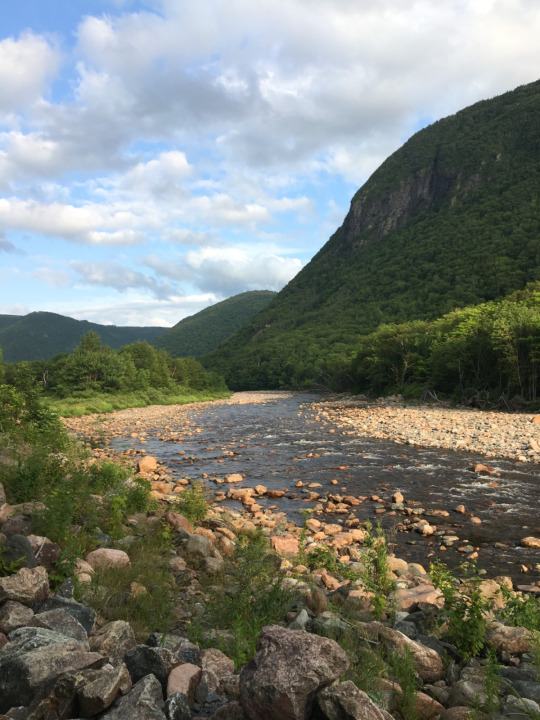
A picture I took at Cape Breton Highlands National Park in Nova Scotia.
My ideal role as an environmental interpreter would be as a park interpreter at a provincial or national park within Canada. My role as park interpreter would involve assisting visitors to explore park trails and swimming areas while providing informational programs safely and respectfully. I would love to run programs such as nature journaling, biodiversity hikes or games such as Wolf Prowl which allows kids to take on roles as animals in an ecosystem. I would also like to help run evening programs that permit visitors to safely explore the trails in the dark which they might not do on their own. As a park interpreter, I would like to focus some programs on establishing people's relationships with nature and sustainability.
The job of an environmental interpreter would require a variety of skills to deliver effective and meaningful interpretation. The skills I first thought of included plant and animal identification and knowledge of ecology, geology, and environmental stewardship. Additional skills in mapping, GPS, and first aid would also be crucial in a role as a park interpreter. Skills in these areas will allow me to be a reliable source of information that visitors can trust with their questions regarding the natural heritage of conservation areas. These areas of knowledge and skills I have listed are essential for environmental interpretation, however, I do not think they are the most important.
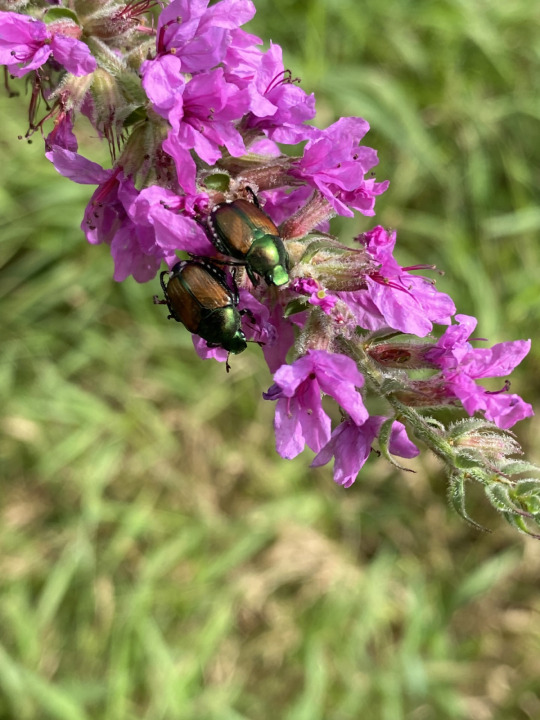
A picture I took of a Japanese beetle (Popillia japonica) on a hike on the Brook Trail in Uxbridge.
Before having the opportunity to work in outdoor education and to read the textbook, Interpreting Cultural and Natural Heritage: For A Better World, I thought knowledge of the environment would be the most important skill to have as an interpreter. However, you could have all the knowledge of nature possible but if you cannot communicate with individuals then you will not be able to effectively share the beauty of nature with others. As described by Beck et al. (2019), communication is the core of cultural and natural interpretation.
In an environmental interpreter role, I would need to be skilled in applying different learning theories and styles to communicate natural surroundings to a diverse group of people. Having the ability to use the Cognitive Development Theory through numerous interpretation forums will allow me to interact with different age groups (Beck et al., 2019). Also, having skills working with multiple intelligences will allow me to connect with a variety of people who learn in different ways (Beck et al., 2019).
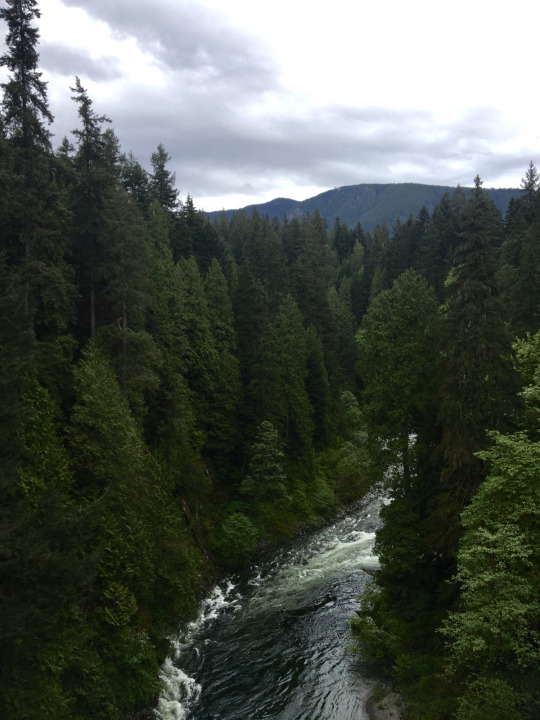
A photograph I took in British Columbia at a Natural heritage site.
As an outdoor education intern, I saw many kids with different interests and ways of learning. Some kids connected better to lessons involving games such as Predator-Prey where they got to run around but still learnt about ecosystem functions. Other kids preferred to explore ecosystems through nature journaling or nature photography programs. All kids were able to leave the outdoor education center with new knowledge and new feelings toward the environment through different pathways.
By utilizing my knowledge of the environment with communication and teaching skills I could succeed as an interpreter at a natural heritage site such as provincial or national parks. Communicating my understanding of different environments and sharing my passion for nature would allow me to guide people to form their own connections and ideas of nature.
References
Beck, L., Cable, T. T., & Knudson, D. M. (2019). Interpreting cultural and natural heritage: For A Better World. Sagamore Publishing.
9 notes
·
View notes
Text
My Dream Role as an Environmental Interpreter
Growing up, I loved opportunities to go on camping trips to various provincial parks in Ontario. I remember visiting Balsam Lake, Sibbald Point, Six Mile Lake, Killbear and Wasaga Beach Provincial Park. I loved exploring these natural areas and discovering new landscapes and environments within Ontario.

A picture I took at Cape Breton Highlands National Park in Nova Scotia.
My ideal role as an environmental interpreter would be as a park interpreter at a provincial or national park within Canada. My role as park interpreter would involve assisting visitors to explore park trails and swimming areas while providing informational programs safely and respectfully. I would love to run programs such as nature journaling, biodiversity hikes or games such as Wolf Prowl which allows kids to take on roles as animals in an ecosystem. I would also like to help run evening programs that permit visitors to safely explore the trails in the dark which they might not do on their own. As a park interpreter, I would like to focus some programs on establishing people's relationships with nature and sustainability.
The job of an environmental interpreter would require a variety of skills to deliver effective and meaningful interpretation. The skills I first thought of included plant and animal identification and knowledge of ecology, geology, and environmental stewardship. Additional skills in mapping, GPS, and first aid would also be crucial in a role as a park interpreter. Skills in these areas will allow me to be a reliable source of information that visitors can trust with their questions regarding the natural heritage of conservation areas. These areas of knowledge and skills I have listed are essential for environmental interpretation, however, I do not think they are the most important.

A picture I took of a Japanese beetle (Popillia japonica) on a hike on the Brook Trail in Uxbridge.
Before having the opportunity to work in outdoor education and to read the textbook, Interpreting Cultural and Natural Heritage: For A Better World, I thought knowledge of the environment would be the most important skill to have as an interpreter. However, you could have all the knowledge of nature possible but if you cannot communicate with individuals then you will not be able to effectively share the beauty of nature with others. As described by Beck et al. (2019), communication is the core of cultural and natural interpretation.
In an environmental interpreter role, I would need to be skilled in applying different learning theories and styles to communicate natural surroundings to a diverse group of people. Having the ability to use the Cognitive Development Theory through numerous interpretation forums will allow me to interact with different age groups (Beck et al., 2019). Also, having skills working with multiple intelligences will allow me to connect with a variety of people who learn in different ways (Beck et al., 2019).

A photograph I took in British Columbia at a Natural heritage site.
As an outdoor education intern, I saw many kids with different interests and ways of learning. Some kids connected better to lessons involving games such as Predator-Prey where they got to run around but still learnt about ecosystem functions. Other kids preferred to explore ecosystems through nature journaling or nature photography programs. All kids were able to leave the outdoor education center with new knowledge and new feelings toward the environment through different pathways.
By utilizing my knowledge of the environment with communication and teaching skills I could succeed as an interpreter at a natural heritage site such as provincial or national parks. Communicating my understanding of different environments and sharing my passion for nature would allow me to guide people to form their own connections and ideas of nature.
References
Beck, L., Cable, T. T., & Knudson, D. M. (2019). Interpreting cultural and natural heritage: For A Better World. Sagamore Publishing.
9 notes
·
View notes